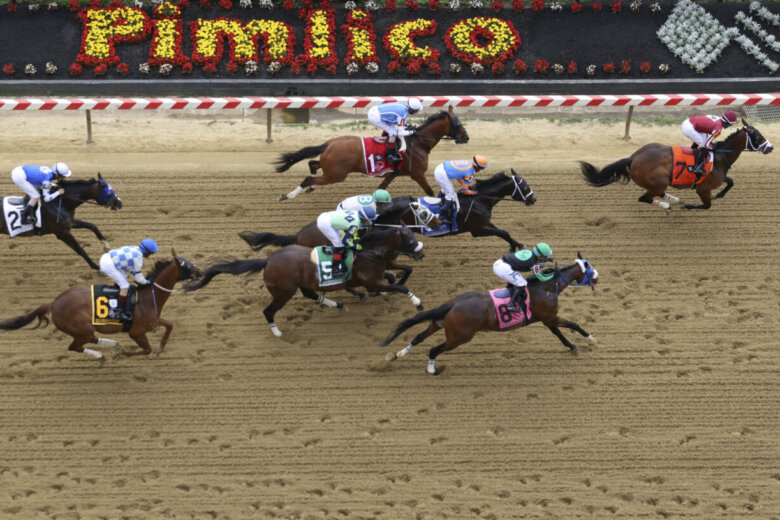This article was republished with permission from WTOP’s news partners at Maryland Matters. Sign up for Maryland Matters’ free email subscription today.

An overhaul of Maryland’s horse racing industry is needed, a new report concludes, and the Preakness could find itself at a new state-of-the-art home in the next few years.
The report released Friday from the Maryland Thoroughbred Racetrack Operating Authority, which was established last year, suggests that the state should completely rebuild the facilities at Pimlico Race Course in Baltimore over the next three years.
The Preakness Stakes, the second jewel in horse racing’s Triple Crown, would be temporarily run at Laurel Park, and return to the new Baltimore facility in 2027.
The proposal, which is dubbed “Pimlico Plus” and subject to legislative and other legal approvals, would pour nearly $400 million into a completely re-envisioned Pimlico site, with a new clubhouse, stables for 700 horses, a 1,000-seat event space, 2,000-car parking garage, veterinary facilities, a possible hotel and other new amenities.
The overhaul is modeled after the horse racing industry in New York, which is home to the Belmont Stakes, the third and final leg of the Triple Crown.
New York is in the midst of renovating Belmont Park, where the race is run.
The Maryland plan contemplates transfer of the Pimlico Race Course land to the state by the current owners, the Stronach Group, which does business as 1/ST and operates here under the Maryland Jockey Club name.
The Canadian-based company would retain intellectual ownership of the Preakness Stakes and Black-Eyed Susan Stakes, which it would license to a nonprofit operating authority to be established by the Maryland Stadium Authority.
The operating group would be modeled after the New York Racing Association and would manage day-to-day horse racing operations in the state beginning Jan. 1, 2025.
The Stronach Group would also retain ownership of Laurel Park, a thoroughbred racetrack located just outside Laurel.
Various state investments that have already been approved by the General Assembly — chiefly the sale of $375 million in bonds for capital improvements at Pimlico and Laurel Park authorized in 2020 — would be poured exclusively into the redevelopment of Pimlico, requiring some terms of the prior authorizations to be changed.
A senior Moore administration official involved with the redevelopment plan said the Stronach Group has been cooperative during deliberations and has agreed to host the Preakness Stakes at Laurel Park during the Pimlico rebuild, though a final legal agreement has not been reached.
Belinda Stronach, CEO and president of The Stronach Group, issued a statement in conjunction with the report’s release.
“The Stronach Group and the Maryland Jockey Club remain deeply committed to reinvigorating Thoroughbred racing in Maryland, and this framework agreement represents an important first step in that process,” she said.
“We want to thank the Maryland Thoroughbred Racetrack Operating Authority for working closely with our team, and for recognizing our investments in these assets. We look forward to a successful racing season in 2024 as we finalize the details of an agreement that will continue The Stronach Group’s and the Maryland Jockey Club’s positive relationship with Maryland racing for years to come.”
If the Preakness were run at Laurel in 2025 and 2026, it would return to Baltimore’s new facility in 2027. At that time, it is anticipated the Stronach Group would sell the Laurel Park land, though the owners could do whatever they want with it, the administration official said.
Rebuilding Pimlico would support 140 to 160 racing days at the site annually. It would also require support from a nearby training facility, and the operating authority recommended three sites: the existing Bowie Race Course Training Center, which Stronach owns; Mitchell Farm in Harford County, and Shamrock Farm, which is about 20 minutes from Pimlico in Baltimore County.
The report released Friday by the Maryland Thoroughbred Racetrack Operating Authority includes concept renderings by Populous, a design firm that specializes in equestrian facilities.
“I am delighted that we were able to chart a course forward for Maryland racing that will ensure the industry continues to thrive for decades to come,” Greg Cross, chair of the Maryland Thoroughbred Racetrack Operating Authority, said in a statement.
“We appreciate the productive dialogue and partnership with The Stronach Group during this process, and we look forward to working together to deliver a first-class experience for racing fans in Maryland and across the country.”
The overall horse industry contributes $2 billion yearly to the economy of Maryland and supports 28,000. The racing sector is estimate to contribute $572 million to the economic impact, according to the report.
“The Authority’s report represents an important next step for the industry,” Gov. Wes Moore (D) said in a statement. “…I look forward to working with the General Assembly and the Maryland Thoroughbred Racetrack Operating Authority to finalize an agreement that ensures this important industry continues to create jobs and drive economic growth for years to come.”








